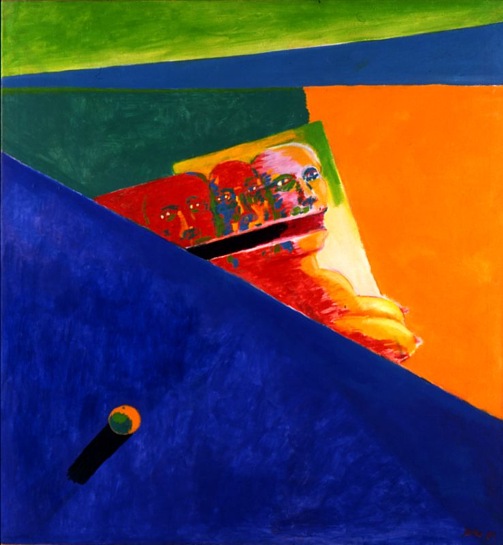City Gallery Prague, Golden Ring House, Prague, Apr 1 – June 28, 2009
The exhibition puts a good selection of works of important Czech artists of the post-war generation on display. All of the exhibits come from the gallery’s own collection. Each artist (Boštík, Boudník, Grygar, Kmentová, Kolíbal, Kučerová, Malich, Nepraš, Sopko, Svobodová, Šimotová) is given a part of the gallery space. The medieval building which houses the gallery is well suited for this kind of arrangement as it consists of a chain of smaller rooms. Yet the space also gives a bit of a cramped impression – it’s definitely not a white cube. There is a short introduction and one or two photoportraits displayed for each artist next to his works. This serves well as it gives you a better sense of orientation. And what does the ‘+1’ in the exhibition title stand for? It stands for Brabec, the photographer of the photo-portraits accompanying every artist’s introductory information. The artists are well-known in the Czech context. The most interesting in the sense of new – for me – were some drawings and sketches of authors who are more famous for their sculptural works, like Kolíbal or Malich.
The artists are well-known in the Czech context. The most interesting in the sense of new – for me – were some drawings and sketches of authors who are more famous for their sculptural works, like Kolíbal or Malich.
I wondered what the impression would be like if this is a visitors first encounter with these artists or czech art from the 1960s – 1980s period in general. As a unknowing visitor, the first thing that would strike me is the „private“ feel to many of the works. Private in the sense of subject matter – many of the works refer to everyday personal experience or feelings. Private also in the sense of small size – the dimensions of the works rarely surpass 1 meter. Within this broadly defined subject, aproaches and interests differ: Everyday objects for Svobodová, the body for Šimotová, corroded walls and metal for Boudník, „energy fields“ percieved by Malich, etc. As a visitor new to Czech art, I would wonder how this came about. One explanation could lie in the nature of the collection – the museum might have been restricted by its budget or exhibition space. But I might offer another explanation.
The career of these artists unfolded during communist rule and they did not belong to the official/officially supported artists. They were surviving. They were doing what they were doing because of their inner conviction. They did not produce for the art market. There was none. They had no commissioned works. Public tenders were handed out according to political and not artistic merit. I think this situation is well illustrated in the photo showing Sopko in his studio – his kitchen. There is a cooker on one side, a kitchen table and two chairs. In the corner a stack on canvases is propped against the wall. I think it is key to consider this historical context when looking at the works. They were created in a time not in favor of art or any kind of free expression. They were created out of personal drive and belief. This makes them very strong in my view. It also helps to compare them to paralel developments in western arts – Malich and Calder, finding pop-art influences in Kmentová’s work, etc. The works on display were created in a different world. Yet there was interaction. The works on display are an outcome of distant influences as much as of the immediate historical situation and personal experience. They are universal in their topics yet they carry the circumstances which helped to form them within.
Seeing these works in historical perspective is a rewarding experience. It creates a personal relartionship with the authors and a deeper understanding. I did not see any metion of this historical perspective in the show. Maybe its in the catalogue which I did not have a look at. I feel its a quite essential piece of information. On the other hand the „small size“ perception is not entirely true. Think of Karel Nepraš’ scultptures or Aleš Veselý’s monumental sculptures (Veselý is not present on this show). This is good to mention to avoid the trap of confusing the piece for the whole. This is one of the problems of the show. I also missed representatives of new forms of expression – like Mlčoch and Štembera for performance/body art or Kovanda for conceptual art. The show is pretty much constructed around traditional forms of expression – painting, sculpture, graphics. It should be acknowledged that in a selection of 10 authors it is hard to represent the whole period. After visiting the show, there are some questionmarks left, but maybe it is even good like that. But it would be nice to include some signs to direct the search for answers in the right direction.